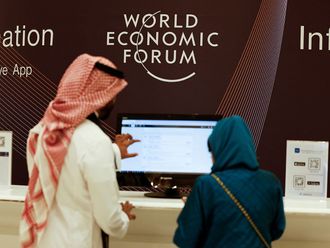
Mumbai: Despite healthy inflow of foreign funds and a strong rupee, the key Indian indices made marginal gains during the just-concluded trade week, as global geopolitical tensions and the Reserve Bank of India’s status quo on interest rates in its first bi-monthly monetary policy review of fiscal 2017-18 hampered their upward movement.
However, even as the Indian equity markets closed with marginal gains, the benchmark indices touched record intra-day highs and closing highs during the week.
On April 5, the BSE Sensex touched a new closing high of 29,974.24 points, after it touched a new 52-week high of 30,007.48 points. Similarly, the NSE Nifty touched a new 52-week intra-day high of 9,273.90 points and a new closing high of 9,265.15 points.
During the week ended April 7, the Sensex rose by just 86.11 points or 0.20 per cent to close at 29,706.61 points, while the wider 51-scrip NSE Nifty closed at 9,198.30 points — up 24.55 points or 0.27 per cent.
“In line with overall positive sentiment in the market aided by the passage of the Goods and Services Tax (GST) Bill and the strengthened position of government after the assembly elections, markets continued to move higher this week before correcting from a high of 9,273,” Deepak Jasani, Head — Retail Research, HDFC Securities, said.
“The mid-cap and small-cap indices outperformed. Market breadth was positive in three out of the four trading sessions of the week.”
Policy review
Vijay Singhania, founder and Director of brokerage firm Trade Smart Online, said: “The rally fizzled out in the last two trading sessions of the week after the minutes of the US Fed’s last policy review induced weakness in global equities and back home, RBI kept the repo rate unchanged at 6.25 per cent in its first policy review of the financial year 2018.”
“Although RBI’s decision to hold rates was mostly factored in, the market reacted negatively, tracking weak global cues. Markets were spooked by the US’ launch of cruise missiles against an airbase in Syria, raising the risk of confrontation with Syrian backers Russia and Iran.”
Singhania pointed out that unabated foreign inflows (of Rs390 billion (Dh22 billion) -- $6 billion — since the start of 2017) lifted the Indian rupee to its best first-quarter performance.
During the week, the Indian rupee appreciated by 56 paise to 64.29 against a US dollar from last week’s close of 64.85.
In terms of investments during the week ended April 7, provisional figures from the stock exchanges showed that FIIs purchased stocks worth Rs7.5 billion during the week, while domestic institutional investors (DIIs) bought scrip worth Rs485.4 million.
Estimates
Figures from the National Securities Depository (NSDL) disclosed that foreign portfolio investors (FPIs) bought equities worth Rs49.9 billion, or $769.96 million, during April 3-7.
“Sentiments got some support after government exceeded the tax collection estimates for 2016-17 fiscal at Rs17.1 trillion, indicating that it should be able to meet the fiscal deficit target for the year, and after the RBI projected India’s growth to strengthen to 7.4 per cent in 2017-18 from 6.7 per cent in 2016-17,” said Dhruv Desai, Director and Chief Operating Officer of Tradebulls.
“Some support also came after the country’s services sector registered second straight month of growth in March, driven by strong rise in new work orders amid softer inflationary pressures.”
Macroeconomic data released during the week showed that India’s services sector continued its recovery for the second successive month in March as the Nikkei India Services Purchasing Managers’ Index (PMI) stood at 51.5 in March. The Nikkei India Manufacturing PMI — which measures India’s manufacturing activity — rose to 52.5 in March from 50.7 in February.
“Sectorally, the top gainers were the capital goods, cement and metal indices. The top losers were the media, realty, banking and pharma indices,” Jasani added
The top weekly Sensex gainers were: Reliance Industries (up 10.73 per cent at Rs1,405.55), Larsen and Toubro (LT) (up 8.27 per cent at Rs1,686.50), Maruti Suzuki (up 5.21 per cent at Rs6,263.95), Tata Steel (up 3.08 per cent at Rs492.90) and NTPC (up 2.66 per cent at Rs167.70).
The losers were: Infosys (down 4.22 per cent at Rs981.25), ITC (down 3.49 per cent at Rs272.75), Sun Pharma (down 3.13 per cent at Rs665.65), HDFC (down 2.64 per cent at Rs1,480.70), and Lupin (down 2.60 per cent at Rs1,410.35).












